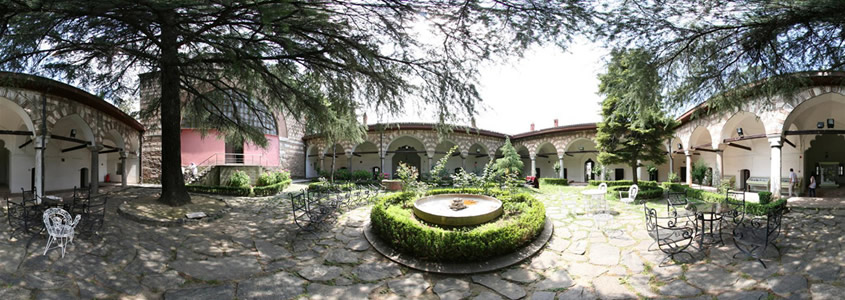Book Online
Monuments and Sites
Weather Forecast
Blue Mosque
The Blue Mosque was commissioned by Sultan Ahmet I when he was only 19 years old. It was built near the Hagia Sophia, over the site of the ancient hippodrome and Byzantine imperial palace (whose mosaics can be seen in the nearby Mosaic Museum). Construction work began in 1609 and took seven years. One of the most notable features of the Blue Mosque is visible from far away: its six minarets. This is very unique, as most mosques have four, two, or just one minaret. According to one account, the Sultan directed his architect to make gold minarets, which was misunderstood as six minarets.
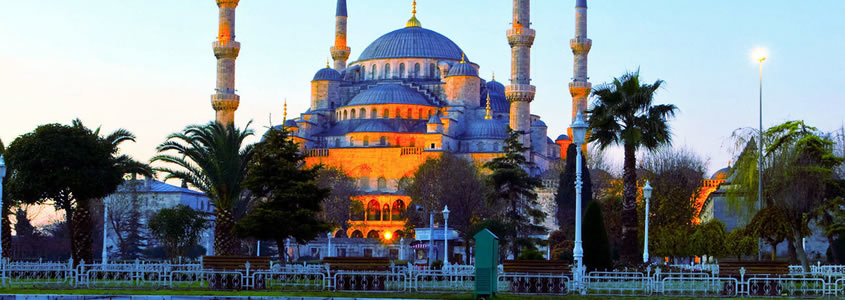
Hippodrome
The Hippodrome was built by the Roman Emperor Septimus Severus in 203 AD and Constantine the Great enlarged and adorned it with beautiful works which were brought from different places of the Roman Empire when he chose Byzantium as his new capital. Although there is not much left from the original building except the Egyptian Obelisk, Serpentine and Constantine Columns, according to the excavations carried out, the hippodrome was 117 m / 384 ft wide and 480 m / 1575 ft long with a capacity of 100,000 spectators.
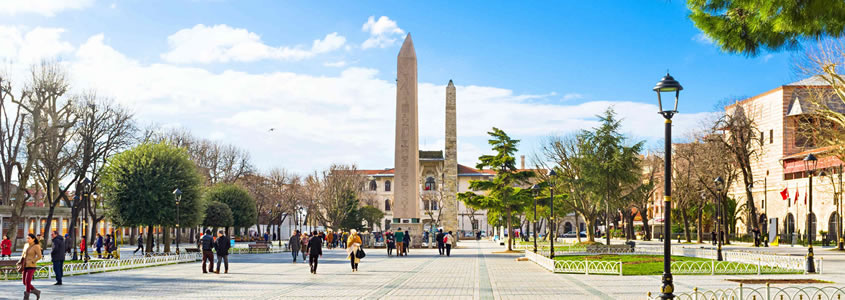
Boukoleon Palace
The Boukoleon Palace was built by Theophilos (829-842) with a facade to the sea on top of the sea walls that had been thickened in this region some decades before. The western part of this facade survived until 1873 when it was demolished to give way for the railway, the eastern part still stands upright. This reconstruction is based on old drawings made before the destruction and the suggestions of E. Mamboury published in 1934. About the back parts of the building behind the facade and the railway nearly nothing is known.
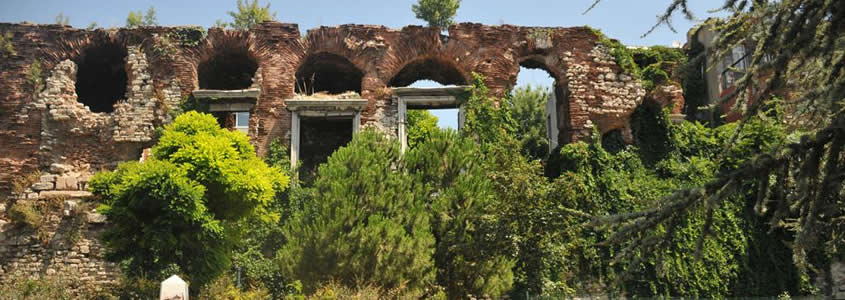
Grand Bazaar
The Grand Bazaar (Kapalıçarşı) in Istanbul is one of the largest covered markets in the world with 60 streets and 5,000 shops, and attracts between 250,000 and 400,000 visitors daily. It is well known for its jewelers, hand-painted ceramics, carpets, embroideries, spices and antique shops. Many of the stalls in the bazaar are grouped by type of goods, with special areas for leather, gold jewelers and the like.
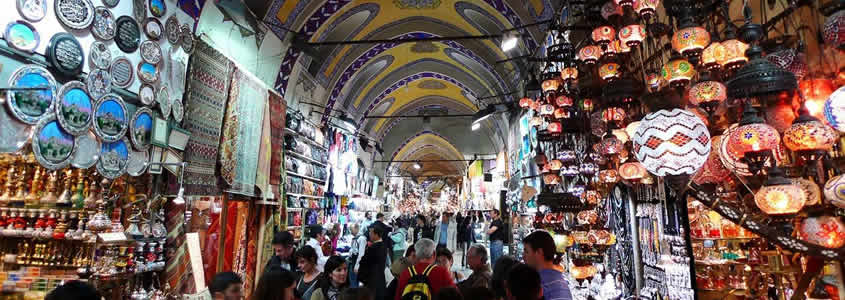
Hagia Sophia
Hagia Sophia, which is considered as one of the eight wonders of the world, also occupies a prominent place in the history of art and architecture. It is one of the rare works of this size and age that has survived to our day. The church (called Ayasofya in Turkish) is erroneously known as Saint Sophia in the west. The basilica was not dedicated to a saint named Sophia, but to Divine Wisdom. After serving two different religions with the same god, 916 years as a church and 477 years as a mosque, Hagia Sophia was converted into a museum on Ataturk's orders. Between 1930 and 1935 the whitewash on the walls was cleaned to reveal mosaics, which are among the most important examples of Byzantine art.

Archaeological Museum
This complex was built by the end of 19th century by the architect Vallaury thanks to great efforts of famous Turkish painter Osman Hamdi Bey. It includes the exquisite Tiled Kiosk and the Museum of the Ancient Orient and houses a large collection of artifacts and works of art belonging to ancient Greek, Roman and other Anatolian civilizations dating back to the 6th century BC. Ancient Eastern Archeological Museum was designed and opened to service in 1917 by Halil Eldem Bey. The collection on displays comprised of about 15000 archeological pieces of Ancient Mesopotamia, Pre-Greek Anatolia, Assyrian, Sumerian, Acadian, Babylonian, Ancient Egyptian and Pre-Islamic Arabic culture.
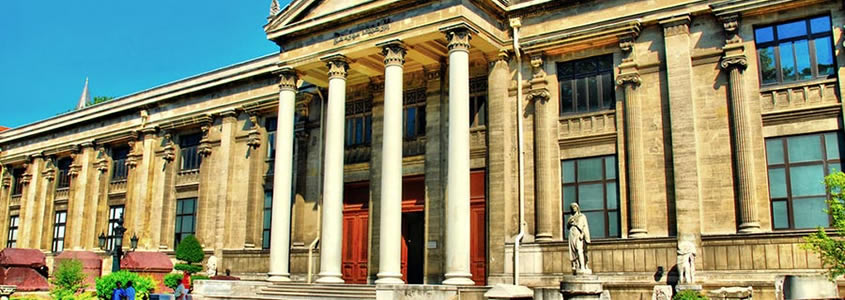
Magnaura
The Senat House was first built after 360 and reconstructed by Justinian I. It is most probably identical with the reception hall of the emperor that was in use at least until the 10th century and mostly simply called Magnaura, from the Latin Magna Aula (Great Hall). The description in the Book of Ceremonies of a reception for an Arabian embassy that was held there in 946 suggests that the Magnaura was not basilical in shape, as this has usually been assumed, but rather a cross-in-square building with a dome, possibly as the result of Justinian's reconstruction.
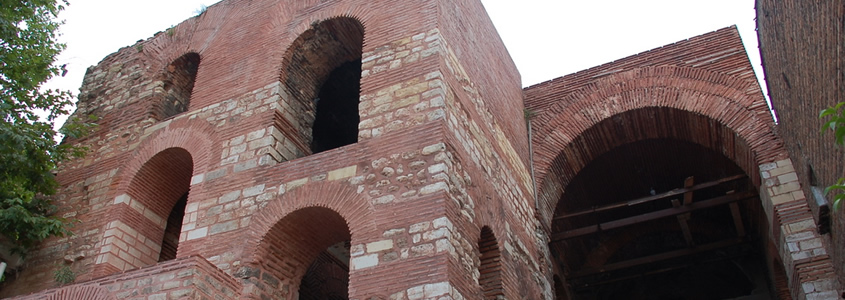
Obelisk
Built of roughly cut stones, this imitation obelisk stands at the southern side of the Hippodrome. Its exact date of construction is unknown. It is named after the Emperor Constantine Porphyroenitus who had it repaired in the 10th century. Its bronze plates decorated with golden lettering were plundered by the Fourth Crusaders.
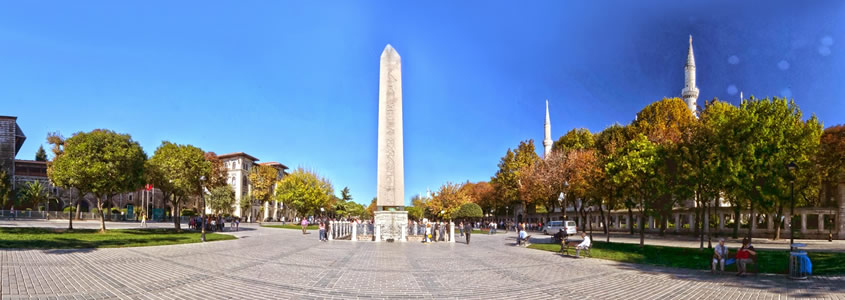
Egyptian Obelisk (The Obelisk of Theodosius I)
Around 1490 BC the Egyptian Pharaoh Thutmose III erected two obelisks before the Karnak temple in Luxor to commemorate the victories of his forces in Mesopotamia. The obelisks were made of rare pink granite. In the 4th century AD, an unknown Roman emperor who wanted to accomplish something impressive that would create excitement among his people had the colossal obelisk brought to Istanbul.

Sokullu Mehmet Pasha Mosque
The Sokullu Mehmet Pasha Mosque was designed by Ottoman imperial architect Mimar Sinan for Grand Vizier Sokollu Mehmet Pasha(husband of one of the granddaughters of Sultan Suleiman the Magnificent, Princess Esmahan.) The construction took place from 1571 to 1572. The mosque is official named after Princess Esmahan, but is more commonly known for its association with her far more famous husband.

Spice Bazaar
Istanbul's Spice Market or Mısır Çarşısı was constructed in 1663 as a part of the adjacent Yeni Mosque complex in order to generate funds for the upkeep of the mosque. Mısır in Turkish means "Egypt" and it is called The Egyptian Bazaar due to the fact that the spices came from India and South-East Asia to Egypt and from there to Istanbul via the Mediterranean Sea. Thus Istanbul marks the last stop along the legendary Silk Road. It was the final destination for Asian goods, which were then distributed to Europe. In fact, Istanbul had developed a spice trade with the Venetians as early as the 13th century.

St. Irene (Aya Irini)
St. Irene was the first church in Istanbul built by Constantine in the 4th century. Justinian later had it restored. It served as the church of the Patriarchate before Hagia Sophia was built. It is the only example of a Byzantine church in the city with its original atrium. The building stands in the outer courtyard of Topkapı Palace and was used as an armory by the Janissaries (Ottoman Soldiers) after the conquest of Istanbul in 1453. Today it serves mainly as a concert hall. Most of the concerts of the Istanbul Festival have been held in St. Irene Church for more than 25 years because of its impressive atmosphere.
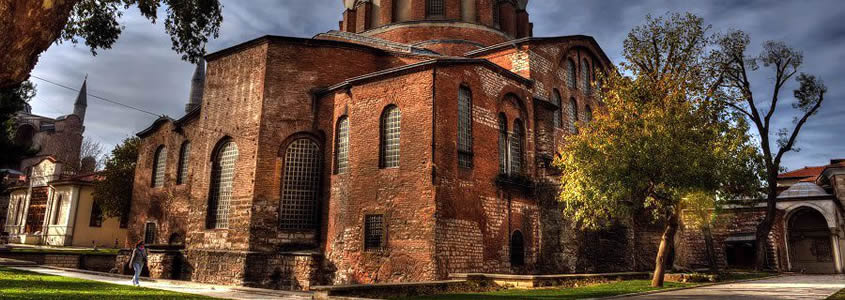
St.Sergius & Bacchus
Small St. Sofia Mosque or St. Sergius and Bacchus church with its former name, which is the useable oldest structure of Istanbul today, was constructed between the years 527-536. According to the legends stated in the sources about the construction of the building (Millingen 1912), at the 1st Anastasyus Period, 1st Justiniaunus and his uncle 1st Justinos were condemned to death due to an allegation that they had a rebellion against the Emperor Anastasyus. One night before the execution, the Emperor Anastasyus sees the saints St. Sergius and Bacchus in his dream and the saints testifies in favor of 1st Justiniaunus and 1st Justinos. The emperor, who is affected by this dream, forgives them. When 1st Justiniaunus becomes emperor, he establishes St. Sergius and Bacchus church as a vow church in order to show his gratitude to these saints.
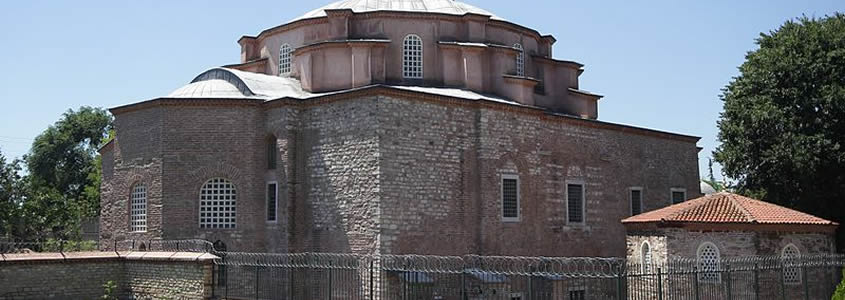
Basilica Cistern
The largest and most magnificent covered cistern in the city is entered through a small building to the west of the Hagia Sophia Square. The ceiling of this forest of columns is made of brick and is cross-vaulted. It was built during the reign of Justinian I (527-565) to supply water to the palaces in the vicinity. Its 336 columns are arranged in 12 rows of 28 each. The cistern measures 140 by 70 meters. The columns are topped with capitals, some of them plain, but most in Corinthian style. The water level in the cistern changed from season to season. The water was distributed through the pipes at different levels in the eastern wall.
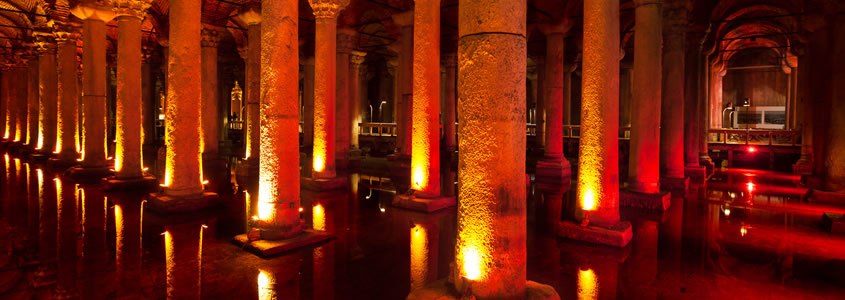
Topkapi Palace
Topkapi Palace is the largest and oldest palace in the world to survive to our day. In 1924 it was turned into a museum for Ataturk’s request. Situated on the acropolis, the site of the first settlement in Istanbul, it commands an impressive view of the Golden Horn, the Bosporus and the Sea of Marmara. The palace is a complex surrounded by 5 km of walls and occupies an area of 700,000 sq. m at the tip of the historical peninsula.

Turkish and Islamic Arts Museum
Istanbul's Turkish and Islamic Arts Museum (Türk-Islam Eserleri Müzesi), on the Hippodrome across from the Blue Mosque, is a treasure-house of beautiful objects from the Ottoman (14th to 20th centuries), Seljuk (11th to 13th centuries), and earlier periods beginning in the 8th century. Turkish carpets, illuminated Kur'ans, calligraphy (at which the Ottomans excelled), carved and inlaid wood, glass, porcelain and stone are well displayed. Turkish ethnographic exhibits—a fully-furnished nomads' tent, a 19th-century Ottoman parlor, and others—extend the collection beyond mere beautiful objects shown out of context.
